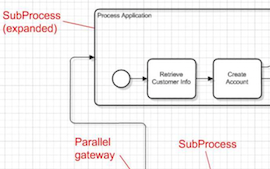
BPMN 2.0 Syntax and Positioning (In-Company)
ON REQUEST
Location: In-company (YOUR COMPANY)
Presented in English by Christian Gijsels
Price: ASK FOR PRICE QUOTE (excl. 21% VAT)
Learning Objectives
What will you learn during this seminar ?
This course is an introduction to BPMN, the "Business Process Model and Notation". It positions BPMN as the second layer of the business blueprint of an organisation. This is the layer beween the "vision" (first layer) and the "Low Level BPM" (third layer, documented in UML).
This course explains the complete syntax of BPMN (both the older versions 1.0, 1.1 and 1.2, as well as the newer versions 2.0 and 2.1) and the relationship with UML - when do you use what ?
Furthermore, we will go deeper into the relationship between BPMN 1.x and BPMN 2.x on the one hand, and the RA(S)CI/PA(S)CI method on the other hand. RA(S)CI (Responsible, Accountable, Sponsor, Consulted, Informed) is a method in which business processes and actors are defined from a vision and/or strategy. This method links roles and responsibilities of project collaborators to the activities that need to be performed. The result is a very useful and transparent process description that can be modelled in more detail in BPMN 1.x or BPMN 2.x.
This seminar helps participants to meet the increasing demands in business process modelling, particularly for business process reengineering (BPR). BPMN can be used to model the current AS-IS and the improved TO-BE situation. BPMN diagrams with sufficient precision and detail can be used to generate e.g. BPEL (Business Process Execution Language) code for the automated execution of processes. Before BPMN, there was no standard modelling language that could support this.

This course gives an answer to these and other questions:
- What is the BPMN format exactly ?
- How do you use BPMN optimally and efficiently to model business processes ?
- What is the link between BPMN and RA(S)CI ?
- When do you use BPMN and when UML ?
- Which tools can help you to model BPMN ?
During this seminar, we will show results from some real-life Belgian case studies, both from the private and government sector.
Why this seminar ?
BPMN stands for "Business Process Model and Notation". This notation is now thé standard for modelling business processes. It allows companies to better understand their internal business processes and to document them in graphical visualisations.
Hence, organisations have the power to describe their procedures in a clear and consistent way. The graphical visualisations facilitate the communication and documentation of business transactions inside and between organisations, allowing them to respond quickly to new business opportunities.
Who should attend this seminar ?
This seminar is aimed at anyone who wants a deeper understanding of process modelling with BPMN, or who wants to start to use BPMN. In particular, we can distinguish 2 major target audiences:
- Corporate and government organisations, looking for a formal way to describe their business processes, including business activities, organisational issues, messages, partners and rules
- Project groups, looking for ways to improve the communication and alignment between business and IT
Within these target audiences, we aim at the following non-exhaustive list of job titles:
- Process and business modellers in BPM projects
- Enterprise architects
- Business & system analysts
- Business Process owners
Full Programme
- The Business Blueprint
- The 3D Enterprise Blueprinting Framework
- The 3-layer model
- Visibility and traceability
- Positioning of BPMN in the 3D Enterprise Business Blueprint
- Definition of a (BPMN oriented) process
- The new Business Ecosystem
- Business Analysis versus Functional Analysis
- BPMN versus UML - when to use BPMN and when to use UML ?
- What is ... EA, BPA, BPMS, BPM, BPMN, Zachman, BPML, BPI, BPEL, XPDL, BPR, Brown Paper, Round tripping, cloud BPM, Social BPM, ... ?
- The RA(S)CI method and its relationship with BPMN
- All about BPMN 1.x
- Other modelling formats like IDEF0, WfMC, RosettaNet, PIPs, UML, DFD, Flowcharts, ...
- The 3 levels of modelling
- The (minimal) BPD Core Element Set BPMN 2.x
- Flow Objects, with examples
- Connecting Objects / Connectors, with examples
- Swimlanes, with examples
- Artifacts, with examples
- The (complete) BPD Core Element Set BPMN 2.x with its new symbols / diagrams
- Data Stores
- Human - User - Service - Scripts tasks
- Sub-Proces/Boundary non-interrupting events
- Parallel multiple
- BPMN Core elements
- Process-, Conversation-, Collaboration- and Choreography diagrams
- Sub-classes / predefined symbol set
- BPMN-posters
- The use of BPMN 2.x symbols
- Syntax improvements in BPMN 2.x compared to BPMN 1.x
- BPMN 1.x versus UML2.x activity diagrams
- Rules and decisions: short overview of DMN (Decision Model Notation)
- The importance of a Lexicon
- Human and physical actors in an organisation
- Hierarchical groups of Actoren in (Hierarchische) Departements / (Process) Teams
- How can you define BPMN actors that you can reuse in UML ?
- RA(S)CI case / process clusters and process levels
- BPMN- and UML-frameworks
- BPMN and Style/framework conventions
- The "connection" between BPMN and UML in a layered architecture
- BPMN 1.x & BPMN 2.x - supported tools
- Drawing tools
- Intelligent drawing tools
- Full Life Cycle tools
- Cloud tools
- BPMN Tools demo
- BizAgi Process Modeller
- Enterprise Architect
- BPMN Tools simulatie demo
- Enterprise Architect 10.0
- Simulator
- Breakpoints
Speakers

Christian Gijsels is an independent consultant at GIJSELSDOTCOM NV. He is specialized in the modelling of business processes (BPMN, UML Activity Diagrams), cases (CMMN), decision rules (DMN), information architecture (Data Flow Diagrams, UML, ...) and business/enterprise architecture (ArchiMate). Before, he was a Director at KPMG Technology Advisory Belgium.
He worked for a long time at the Cronos Holding, where he was co-founder and responsible for the Consulting Practice The Business Analysts, a group of 55+ Strategy, Business and Functional analysts and project managers. Before this, Christian was e-Business Manager at KPMG. Christian Gijsels is a member of BPM Institute and is actively in touch with Bruce Silver, the founder of BPMN.
Christian finished his Master in Computer Technology at the LUC, and holds many certifications, e.g. Certified Advanced Consulting Skills (KPMG Verona), Certified PDN (Consulting Problem Solving), Certified Teacher at IBM Belgium, and Internal Auditor Quality System ISO 9001:2000 (SGS Belgium), Certified Scrum Master/CSM at Scrum Alliance, Certified BPMN at BPMInstitute.org New York (Bruce Silver), and KMO Challenge at Vlerick Leuven Gent Management School. He is also certified Scrum PO, and Certified in ArchiMate and Six Sigma.
You can find more about Christian at LinkedIn and follow his tweets at Twitter.
Check out these related open workshops:
- Generatieve Business Analyse (4de sessie) (May 28, 2024)
Check out our related in-house workshops:
- BPMN 2.x in Practice (In-Company Workshop) (INHOUSE WORKSHOP - On Request)
- Case Modellering en CMMN in de Praktijk (INHOUSE WORKSHOP - On Request)
- Business Analyse Technieken (Workshop) (INHOUSE WORKSHOP - On Request)
- BPMN Jumpstart (In-Company) (INHOUSE WORKSHOP - On Request)
- Case Modelling and CMMN in Practice (INHOUSE WORKSHOP - On Request)
- Lean Business Analyse (INHOUSE WORKSHOP - On Request)
- BizAgi Modeler in Theorie en Praktijk (INHOUSE WORKSHOP - On Request)
- Business Analyse Technieken (Tweedaagse Workshop) (INHOUSE WORKSHOP - On Request)
- Business Rule Modellering met DMN en BPMN (INHOUSE WORKSHOP - On Request)
- End-to-end Modelling with Sparx Enterprise Architect (INHOUSE WORKSHOP - On Request)
- Business Analysis Agility (INHOUSE WORKSHOP - On Request)
- Minimum Viable Products (MVPs) Demystified (INHOUSE WORKSHOP - On Request)
Questions about this ? Interested but you can't attend ? Send us an email !